Blog Contributors—Sarita Raengpradub and Kristen Rowell
The recent European Commission survey into herbs and spice authenticity highlighted the vulnerability of this integral portion of the food supply chain. Herbs, spices, and botanicals are especially susceptible to fraud for various reasons, such as the supply chain's complexity, the products' high value, and the amount of processing required to get to the finished product.
Due to this increased risk, producers of these products are working diligently to safeguard the supply chain of their products and looking for the best way to ensure that they are getting what they are paying for. There have been various ways that authenticity has been determined in these types of products, but one of the best ways is to identify the plant being harvested for the product.
Now, when it comes to taxonomic species identification, there are a few different ways to go about it, including morphological, biochemical, and molecular means. For example, traditional plant species identification is done by examination of morphological characteristics by a botanical expert. However, this approach does not lend itself well to food authenticity and food fraud testing purposes, especially for complex matrices (i.e., products composed of mixed species). A DNA-based methodology known as DNA barcoding has become a standard technique for plant species identification. The Consortium for Barcode Life was created partly to support the establishment of DNA barcoding as a global standard for species identification.
DNA barcoding works by sequencing a short DNA fragment from a specific gene or genes. There are a few target genes to choose from for plants, including matK, rbcL, psbA-trnH, and ITS1. DNA is extracted from a sample, and PCR is used to amplify the target gene region(s). The amplified PCR fragments are subsequently sequenced and compared to a reference database of sequences to assign a taxonomic identification. Think of it like this: each plant species has a unique sequence that can be used to identify it, much like how a Universal Product Code (UPC or product barcode) is used to distinguish products from one another in a supermarket’s inventory.
Typically, DNA barcoding utilizes Sanger sequencing, a tried-and-true technique for acquiring barcodes. However, one of the main limitations of this first-generation sequencing methodology is that it can only be applied to a single DNA template at a time (i.e., a sample composed of an individual species); it cannot be used for multiple templates, whether it be multiple fragments (from different genes) simultaneously or for a sample composed of mixed species.
DNA metabarcoding is DNA barcoding powered by next-generation sequencing (NGS) technology. NGS is next-level technology that enables DNA sequencing in a massively parallel manner; the output of NGS is millions of DNA sequence fragments. This approach allows the sequencing of multiple samples and genes simultaneously; thus, plant species identification from complex samples is possible. One important thing to know is that the bioinformatics associated with NGS (i.e., the computational analysis to decipher all that sequence information) tends to be much more involved and challenging, and it is also critical to the method's success.
DNA metabarcoding has emerged as a powerful way to combat food fraud and enhance authenticity. This NGS-based approach for taxonomic species identification can authenticate ingredients and detect unexpected contaminations; it is an essential analytical tool for food safety, quality, and authenticity.
Mérieux NutriSciences is excited to offer DNA metabarcoding at our Silliker Food Science Center in Crete, IL. Please contact us for more information.
